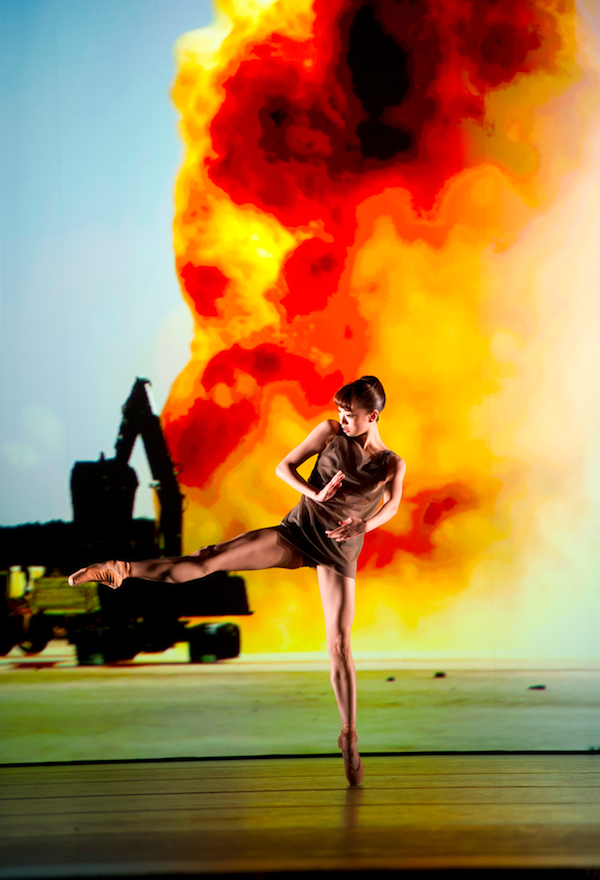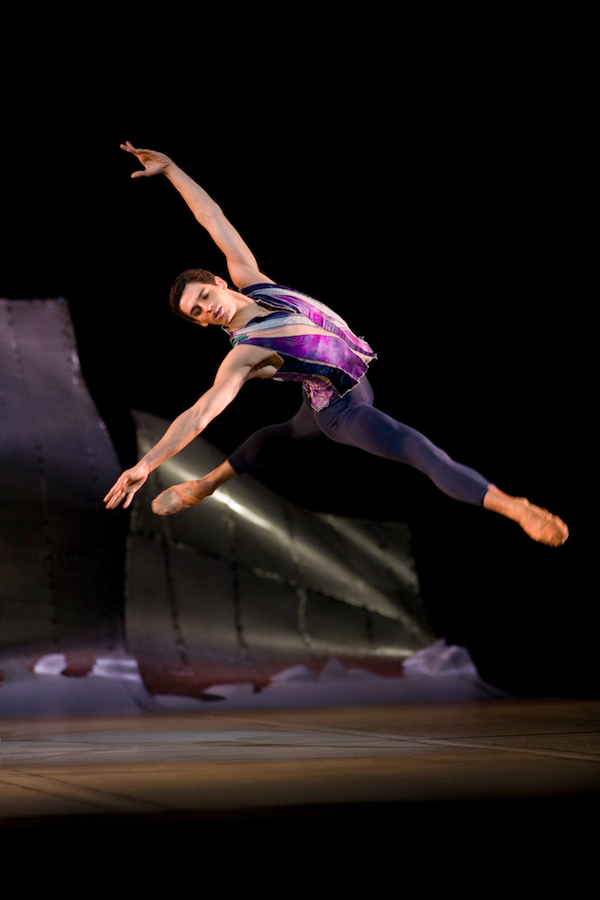Current affairs can be an on-trend choreographer's nemesis. In the new triple bill at the Royal Ballet last night, you could watch a new video-game war-ballet by Wayne McGregor, while blotting out thoughts of the Taliban suicide massacre in yesterday’s headlines, and Christopher Wheeldon’s DGV, with its modish wrecked train set, while trying to forget that yesterday expensive retribution was demanded of Network Rail for the Potter's Bar train crash. Not wholly helpful associating, as neither piece is among their creator’s best.
The evening’s success had to hang on the chiffon frivolity of the debut in the Royal Ballet of a bubbling, bravura ballerina work by Balanchine only 17 minutes long, which is little more than a virtuoso pas de deux with a lightweight corps attached. However, the lip-smacking success of last night’s show of Ballo della regina ("The Queen’s Ball") was down less to the leading ballerina than to the only man on stage - Sergei Polunin, unleashing his greyhound grace and majestic macho in leaps that politely defied gravity, while paying the kind of courtesy to the rabble of girlish pulchritude around him that makes a ballerina weak at the knees. In fact, perhaps Marianela Nuñez was weak at the knees, as she seemed so wreathed in smiles at him that she missed a few of the difficult roulades in the breathlessly nimble choreography. Ballo del re, more like.
With its giddy Verdi music and its effervescent brevity, Ballo should have been the merest bonne-bouche for the traditional yearly thrill of a new McGregor, always guaranteed to be weighty with portent and rich in theory. In Live Fire Exercise it is not physics or medical science that we are to sup in lengthy programme essays, but a stew of "radical", "complex" and "innovative" philosophical theories about war and ballet, and how McGregor's choreography means "multiple coordinations as a way of traumatising the body", though I'd hazard that it's the boys' toys of digital game visuals that really appealed here.
 War is understandably a preoccupation for creative artists just now - young Liam Scarlett used it obliquely and movingly in his elegiac ballet Asphodel Meadows a year ago but Live Fire Exercise makes it full-frontal without winning any belief in it as other than an image-making exercise. His six dancers in khaki underwear are busy, nervy, ant-like forms before John Gerrard’s huge video sequences of army trucks in the desert occasionally being blown up - they gust from side to side, they teeter and skitter, weightless avatars in a video game, in some other world from the consuming emotional urgency of Michael Tippett’s Fantasia Concertante on a Theme of Corelli which fills the house with plangent, trilling strings, driving past each other at different speeds, antique echoes, blurs, discords and asynchronicities mounting, only to collide periodically in marvellous romantic cadences.
War is understandably a preoccupation for creative artists just now - young Liam Scarlett used it obliquely and movingly in his elegiac ballet Asphodel Meadows a year ago but Live Fire Exercise makes it full-frontal without winning any belief in it as other than an image-making exercise. His six dancers in khaki underwear are busy, nervy, ant-like forms before John Gerrard’s huge video sequences of army trucks in the desert occasionally being blown up - they gust from side to side, they teeter and skitter, weightless avatars in a video game, in some other world from the consuming emotional urgency of Michael Tippett’s Fantasia Concertante on a Theme of Corelli which fills the house with plangent, trilling strings, driving past each other at different speeds, antique echoes, blurs, discords and asynchronicities mounting, only to collide periodically in marvellous romantic cadences.
In fact, the music is so overwhelming that the itchy-scratchy dance calligraphy in half-dark makes no impact on it, for all the efforts of Akane Takada and Ricardo Cervera in particular to imprint some kind of personality on their expertly minced, chopped and broken movements. (Takada pictured right © Bill Cooper.) Possibly Gerrard is complementing McGregor’s mission of enlightenment with his virtual-reality images. But then again, possibly this is just an eye-catching cliché being pushed into position, so that the effortless dance scribbling can simply resume where it stopped in the previous radical, complex, innovative new McGregor piece.
After McGregor’s busy-busyness, Wheeldon’s slick 2006 DGV: Danse à grande vitesse feels like a sibling of exactly the same family: the visual image not trucks but trains, the dancers not six nervy avatars but eight elusive time-travellers whose dance-shapes wisp, curl and bobble. The set is a picturesque wreck of steel, with a great sharp light over it, and again there is an overbalancing score, this time negatively, in Michael Nyman’s repetitious, chugging wallpaper music, MGV, written for the inauguration of a new French TGV. The name’s much the wittiest thing about it.
 Wheeldon uses a stretched and pliant line that contrasts not uninterestingly with McGregor’s phased, blippy fragments, both of them good students of late Eighties William Forsythe. Wheeldon, though, seems to understand the graphic dimensions of partnering better (a throwback to his Balanchine apprenticeship with the New York City Ballet, surely), and marshals his four couples and 18 supporting dancers in stronger formation effect. (Federico Bonelli pictured left © Johan Persson/ROH.)
Wheeldon uses a stretched and pliant line that contrasts not uninterestingly with McGregor’s phased, blippy fragments, both of them good students of late Eighties William Forsythe. Wheeldon, though, seems to understand the graphic dimensions of partnering better (a throwback to his Balanchine apprenticeship with the New York City Ballet, surely), and marshals his four couples and 18 supporting dancers in stronger formation effect. (Federico Bonelli pictured left © Johan Persson/ROH.)
Zenaida Yanowsky looks magnificent in this kind of work, statuesque and bronzed, and she’s given eloquent support by Eric Underwood. Still better, though, are Gary Avis and the classy Melissa Hamilton (in Darcey Bussell’s original role), with Avis effortlessly bearing Hamilton aloft with the instinctive fastidiousness of a porter carrying an ostrich-skin valise to the luggage rack. There is possibly the faintest smile towards Jerome Robbins’s The Concert, but overall DGV is a great concept and set (Jean-Marc Puissant), running on dreary musical rails along which the choreographic train doesn’t go very far. Nor does the evening, as dance. But hats off to the Royal Opera House orchestra, handling the Verdi, Tippett and Nyman with equal respect - that's professionalism.
- The Royal Ballet's triple bill of Balanchine, McGregor and Wheeldon has performances until 25 May
- See what's on at the Royal Ballet. Read Royal Ballet reviews
- John Gerrard’s visual motion-capture installation Infinite Freedom Exercise (near Abadan, Iran), 2011 is showing at the Manchester International Festival in Lincoln Square, Manchester, 5-17 July
Watch Merrill Ashley discuss and coach Ballo della regina with the Royal Ballet














Add comment